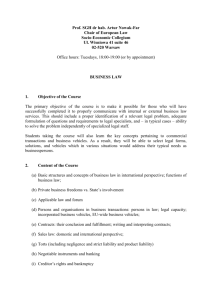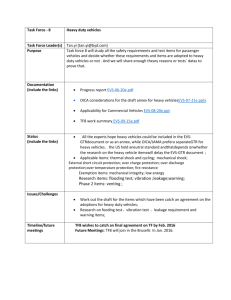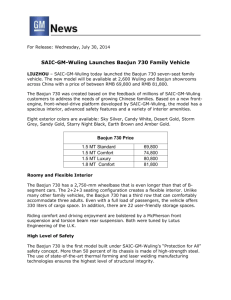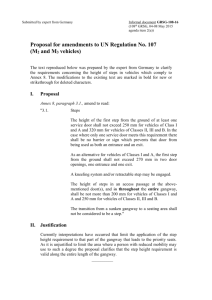EVE-14-07-Rev1e
advertisement
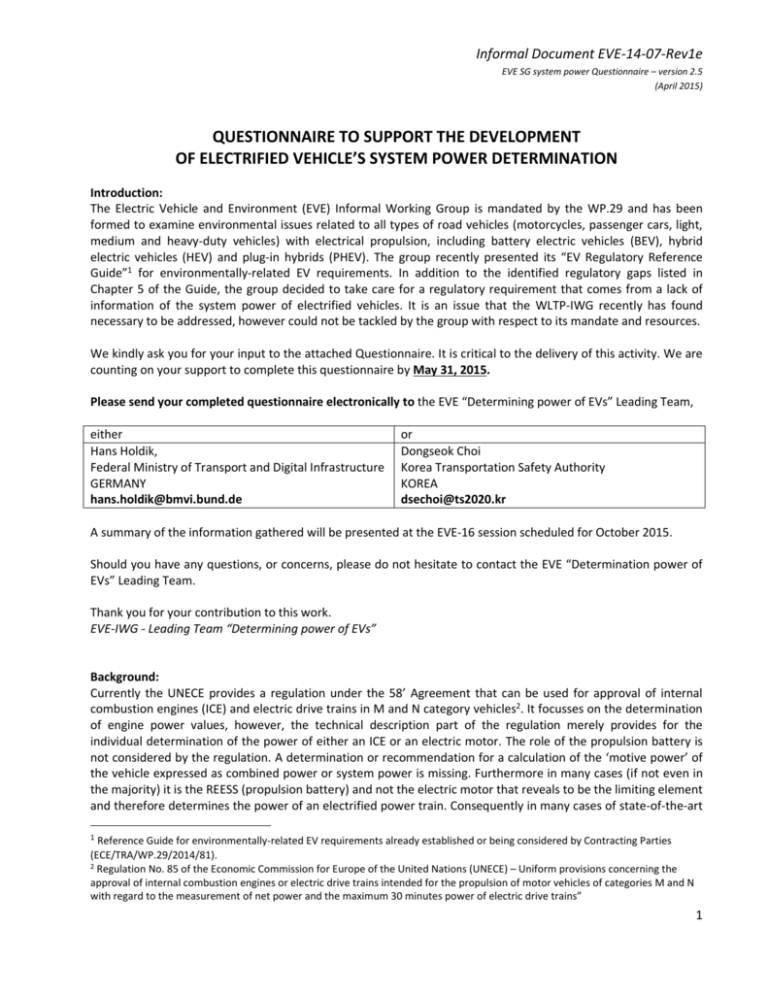
Informal Document EVE-14-07-Rev1e EVE SG system power Questionnaire – version 2.5 (April 2015) QUESTIONNAIRE TO SUPPORT THE DEVELOPMENT OF ELECTRIFIED VEHICLE’S SYSTEM POWER DETERMINATION Introduction: The Electric Vehicle and Environment (EVE) Informal Working Group is mandated by the WP.29 and has been formed to examine environmental issues related to all types of road vehicles (motorcycles, passenger cars, light, medium and heavy-duty vehicles) with electrical propulsion, including battery electric vehicles (BEV), hybrid electric vehicles (HEV) and plug-in hybrids (PHEV). The group recently presented its “EV Regulatory Reference Guide”1 for environmentally-related EV requirements. In addition to the identified regulatory gaps listed in Chapter 5 of the Guide, the group decided to take care for a regulatory requirement that comes from a lack of information of the system power of electrified vehicles. It is an issue that the WLTP-IWG recently has found necessary to be addressed, however could not be tackled by the group with respect to its mandate and resources. We kindly ask you for your input to the attached Questionnaire. It is critical to the delivery of this activity. We are counting on your support to complete this questionnaire by May 31, 2015. Please send your completed questionnaire electronically to the EVE “Determining power of EVs” Leading Team, either Hans Holdik, Federal Ministry of Transport and Digital Infrastructure GERMANY hans.holdik@bmvi.bund.de or Dongseok Choi Korea Transportation Safety Authority KOREA dsechoi@ts2020.kr A summary of the information gathered will be presented at the EVE-16 session scheduled for October 2015. Should you have any questions, or concerns, please do not hesitate to contact the EVE “Determination power of EVs” Leading Team. Thank you for your contribution to this work. EVE-IWG - Leading Team “Determining power of EVs” Background: Currently the UNECE provides a regulation under the 58’ Agreement that can be used for approval of internal combustion engines (ICE) and electric drive trains in M and N category vehicles2. It focusses on the determination of engine power values, however, the technical description part of the regulation merely provides for the individual determination of the power of either an ICE or an electric motor. The role of the propulsion battery is not considered by the regulation. A determination or recommendation for a calculation of the ‘motive power’ of the vehicle expressed as combined power or system power is missing. Furthermore in many cases (if not even in the majority) it is the REESS (propulsion battery) and not the electric motor that reveals to be the limiting element and therefore determines the power of an electrified power train. Consequently in many cases of state-of-the-art 1 Reference Guide for environmentally-related EV requirements already established or being considered by Contracting Parties (ECE/TRA/WP.29/2014/81). 2 Regulation No. 85 of the Economic Commission for Europe of the United Nations (UNECE) – Uniform provisions concerning the approval of internal combustion engines or electric drive trains intended for the propulsion of motor vehicles of categories M and N with regard to the measurement of net power and the maximum 30 minutes power of electric drive trains” 1 Informal Document EVE-14-07-Rev1e EVE SG system power Questionnaire – version 2.5 (April 2015) power train concepts of electrified vehicles, the concept of an individual determination of the engine’s or electric motor’s power is unsufficient or even leads to misinterpretation of results. This holds for cases, where distinct information about the combined power of the system is eligible or needed. System power specifications may be used in different fields. Among others, it may serve as customer technical information (e.g. maximum declared power), may be used by the legislator (as basis for taxation schemes) or by insurance providers (as a classifier for tariff determination). Further on, a strong demand for an improved power determination prescription currently comes from the WLTP-IWG3 subgroup “electrified vehicles” that needs a system power specification for the classifications of electrified vehicles into distinct power-to-mass ratio classes, for the application of the so-called downscaling method that enables adaption of the test cycle for low powered vehicles and for the application of the WLTP gear-shift-calculation model. The outlined situation may become even worse, since in future more and more sophisticated hybrid vehicle concepts for instance with distributed power sources are likely to gain market maturity (e.g. electrified vehicles with rim motor concepts). Being aware of this and according to its mandate, the IWG on EVE4 meanwhile has identified action demand and therefor established a subgroup (SG) “Determining power of EVs” It’s mission is to clarify, how an improved technical prescription for the determination of the system power of sophisticated powertrains like applied in pure and hybrid electric vehicles, could be realised under the ceiling of the UNECE. Scope of the work covers light duty vehicles (M1 and N1) and shall result in a recommendation or regulation for determination of the performance criteria “power” and “torque”. The group agreed upon organising the work in two parts. The first part shall be spent for gathering all necessary information, in an open and transparent way, for instance about, stakeholders to be invited to participate in the process so that they can share their potential interest and expertise, which system power information is of potential interest for the individual stakeholders and for which individual purposes, identification of other working groups that are currently involved in similar work and potential synergies that could be used. Results from the study shall be used thereafter to compile an appropriate project work plan that should allow for all so far identified issues. Depending on the character of the points to be handled, there will be decision making processes necessary for political questions or research work for the clarification of technical questions. The purpose of the following questionnaire is to gather information from possible stakeholders about their demands and attitudes in this subject. Instructions: For each item presented below, please provide answers to the questions. We realize there may be overlap in requirements for multiple attributes; if this is the case, include information in each attribute even if repetitive. 3 Worldwide harmonized light vehicles test procedure https://www2.unece.org/wiki/pages/viewpage.action?pageId=2523179 EVE-IWG has been established in 2012 under the Working Party on Pollution and Energy (GRPE) and is reporting to GRPE and the WP.29. The Terms of Reference of the EVE IWG can be found at: https://www2.unece.org/wiki/display/trans/EVE+2nd+Session 4 2 Informal Document EVE-14-07-Rev1e EVE SG system power Questionnaire – version 2.5 (April 2015) QUESTIONNAIRE Question 1: Regulatory Approach What would be your preferred option regarding the regulatory approach under the WP.29 / GRPE? Background information: Harmonisation of technical prescriptions of Contracting Parties with respect to wheeled vehicles, equipment and parts is the declared objective of both the 1958 and 1998 Agreements. Before the actual project could start one issue comes with the regulatory approach that should be followed under the WP.29 / GRPE. Basically WP.29 provides for two options that could be chosen for an appropriate application of a mandate. EV system power determination could be developed, either 1. as a Regulation, or 2. as a Recommendation / Mutual Resolution. Regulations could be annexed either to the 1958 Agreement as part of the type approval methodology or to the 1998 Agreement, as part of the GTR repository. While one could deem the amendment (extension) of a topic- related regulation a direct and straightforward way to accomplish the outlined objective, it must be stated that UN Regulations, as being part of the type approval methodology, are less suited for an extended international harmonisation level. On the other hand, an international fully harmonised approach would need a development of an entirely new GTR, which could be eventually very time-consuming. Should it turn out that an agreement on a regulatory level could not be achieved, WP.29 provides for a second category of formal instruments that work like mutual adopted rules or recommendations. These recommendations or mutual resolutions, however, are not mandatory to the contracting parties. ANSWER (tick only one box and/or give some explanation): The prescription for determination of a system power of M1, N1 vehicles should be developed, ☐ by an amendment /additional module of the UN ECE No. 85 under the 58’ Agreement. ☐ by a new GTR or new module to an existing GTR under the 98’ Agreement. ☐ by a new Recommendation / Mutual Resolution (or an additional module to one of these) annexed to the 98’ and/ or 58’Agreement. ☐ by other means, and that is: <Please indicate and add some background explanation > For what purpose do you plan to use the outcome of this task in your country? ☐ for WLTP ☐ for other purpose (please describe in detail) ☐ not having concrete ideas in particular Space for general comments: Please give your comments / recommendations 3 Informal Document EVE-14-07-Rev1e EVE SG system power Questionnaire – version 2.5 (April 2015) Question 2: Motive Power and appropriate measuring values Do you have requirements (voluntary, regulatory, etc.) in regards to appropriate power ratings that a new regulation / recommendation should / include? The term ‘requirements’ is broad and can refer to any practise, regulation, legislation, code, and/or standard. Please keep in mind that the outlined undertaken “system power determination” focuses on electrified M1, N1 vehicles only (HEVs, PHEV, BEVs passenger cars and light commercial vehicles). If appropriate, specify individual requirements by vehicle type. Describe the requirements, stating its objective and goal. Indicate if the requirement is already established/ active or under development on a regional level. If the requirement is under development, what is the expected timeline for its adoption? Finally, if a definition of the particular power attribute is included in the requirement, please provide this information. Background information The current UN Regulation No 85 (UN-R85) provides for combustion engines a measuring value of the Net Power (NP) and for electric motors of a drive train the 30 min Maximum Continuous Net Power (MCNP). In case of multiple propulsion systems like with hybrid vehicles R85 does not account for the amount of power each path is actually providing in a particular driving phase. Generally speaking, the arithmetic sum of power of the individual motive sources does not reflect the correct actual power of the vehicle. In addition, the traction battery is the limiting power element in the majority of cases. This could affect the proper classification of BEVs and vehicles with hybrid powertrains regarding for instance taxation schemes or insurance tariffs and makes it difficult for e.g. customers, to compare the motive power of two vehicles with different power train concepts. ANSWER (tick only more than one box, where appropriate. Feel free to give an alternative proposal or a general comment): ☐ No, I haven’t any further requirements that would go beyond the current status of UN-R85. ☐ Yes, in fact the Net Power ratings from current UN-R85 are sufficient but the power limit ascribed to the traction battery should be properly considered and determined. The regulation should then accordingly be adapted. ☐ Yes, a prescription for determination of a “combined system power” of M1, N1 HEV, PEHV, BEV vehicles should be entirely new developed and I have the following requirements for power rating information: ☐ Information / power ratings about the complete power train should be given and should include following ratings (tick more than one box, if appropriate) ☐ Maximum Net Power and Torque (Peak Power) / best case configuration and pre-condition ☐ Average Net Power and Torque / representative case configuration and pre-condition ☐ Minimum Net Power and Torque/ worst case configuration and pre-condition ☐ Other, and that is: <Please give your proposal <Description> <Objective and goal> <Established / active or under development> <If under development, timeline for adoption> <power attribute definition found in the requirement> < any SAE, ISO, UL, national, international, voluntary, industry etc. standards referenced in the requirements? If yes, list the standards referenced> Space for general comments: <Is there any other relevant related information you would like to include? - Please give further comments /suggestions / recommendations, if you wish> 4 Informal Document EVE-14-07-Rev1e EVE SG system power Questionnaire – version 2.5 (April 2015) Question 3: Which technical procedure is appropriate? Requirements: Do you have requirements (voluntary, regulatory, etc.) in regards to the test procedure? The term ‘requirements’ is broad and can refer to any practise, regulation, legislation, code, and/or standard. Please keep in mind that the outlined undertaken “system power determination” focuses on electrified M1, N1 vehicles only (HEVs, PHEV, BEVs passenger cars and light commercial vehicles). If appropriate, specify individual requirements by vehicle type. Describe the requirements, stating its objective and goal. Indicate if the requirement is already established/ active or under development on a regional level. If the requirement is under development, what is the expected timeline for its adoption? Background information Currently the UN-R85 provides for the determination of power ratings regarding internal combustion engines or electric motors obtained on a test bench at the end of the crankshaft (the so-called Net Power). Once the particular demand for power ratings of the total system is defined, an appropriate technical approach must be determined. It is foreseeable that three levels of technical procedures are able to be applied. The accuracy of results depends on the level of additional expenses of preparative and measurement work. However, it must be considered that practicability and a well-balanced cost- benefit relation of the technical procedure is given. ANSWER (Tick only one box. Feel free to give an alternative proposal or a general comment): ☐ Determine net power and torque of each individual component (engine or electric motor) and estimate / calculate the system power and torque by means of a computational model / mathematical procedure. ☐ Determine the system power and torque directly by using a test bench configuration/ hardware-in-theloop set-up. ☐ Determine the power and torque at the wheels of an entirely assembled vehicle applying a kind of chassis dyno or powertrain dyno measurement. ☐ Other, and that is: <Please give your proposal <Description> <Objective and goal> <Established / active or under development> <If under development, timeline for adoption> <power attribute definition found in the requirement> < any SAE, ISO, UL, national, international, voluntary, industry etc. standards referenced in the requirements? If yes, list the standards referenced> Space for general comments: <Is there any other relevant related information you would like to include? - Please give further comments /suggestions / recommendations, if you wish> 5



